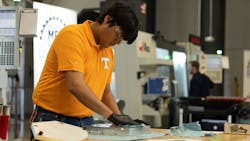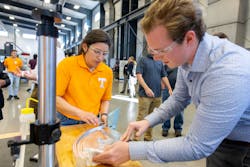Tennessee students win inaugural SEC Machining Competition
The event challenged teams of undergraduate and graduate students studying advanced manufacturing and advanced materials to use computer numerical control (CNC) machines to create a quadrant of the SEC logo.
At the heart of the competition was a goal to better prepare students for competitive careers by merging engineering theory and design work from the classroom with production experience using industry-relevant machine tools.
Student-led teams from UT, Texas A&M University, Auburn University and Mississippi State University competed two at a time on Haas VF-4SS three-axis CNC machines.
Also read: Machining is a team sport
Teams were scored based on time, cost and accuracy (Figure 2). Audience members included invited middle- and high-school students from around eastern Tennessee, as well as Greene Technology Center.
Lead competition judge Scott Smith, acting section head for precision manufacturing and machining at Oak Ridge National Laboratory, explained the collegiate spirit of the competition.
“At first we planned to have each team machine a common part, a true point-to-point comparison,” said Smith. “But the more we thought about the spirit of competition, we realized that the SEC logo, broken into quadrants, had equitable complexity. It seemed like a better idea to have each team machine one quadrant of the logo and have all four teams form the SEC logo together. In the end, we are all working together.”
“The biggest factor is quality,” said Cornelius. “The way points are rated—there are 270 points total, and, of that, 40 are attributed to things such as tool cost, cycle time and people in the work zone. The rest of the points relate to quality, so if all teams produce accurate components it might come down to those other factors.”
The competition was made possible by the U.S. Department of Defense Industrial Base Analysis and Sustainment program. Project MFG ran the competition with support from America’s Cutting Edge, IACMI–The Composites Institute, the UT-Oak Ridge Innovation Institute, the Gene Haas Foundation and MSC Industrial Supply. In addition, 20 professional organizations staffed tables with representatives to speak to visiting students about future manufacturing-related careers.
Also in attendance to view the competition and meet with students was Halimah Najieb-Locke, deputy assistant secretary of defense for industrial base resilience.
The event was the brainchild of UT Professor of Mechanical Engineering Tony Schmitz, who was inspired to create a machining competition based on his experience playing college football.
“This competition is indicative of my entire research career,” Schmitz stated. “I’ve spent 20 years thinking about machine tools and how to teach about them. When people think about the manufacturing workforce, they often think about people running equipment. That’s important, but I think about more: about people that design the equipment and the processes. The students that compete today, and the students we reach through events like this, will be reinvigorating U.S. manufacturing by becoming the thought leaders, the company owners and the engineers that progress us forward.”
Schmitz’s vision for the competition is to expand it to include all SEC universities and eventually other conferences across the nation.




